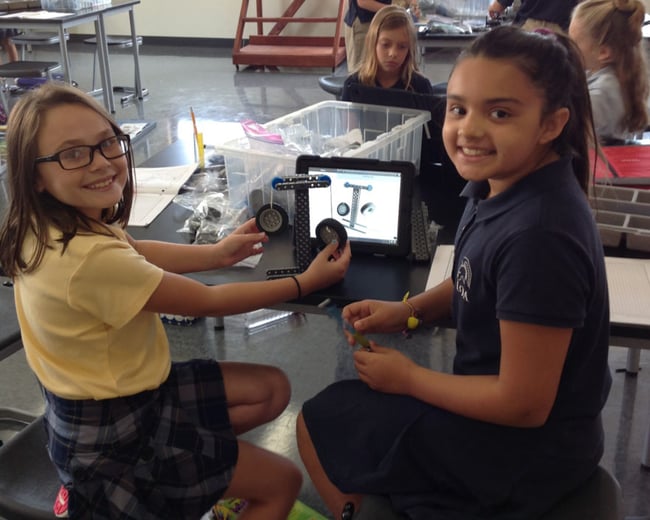Clay McElheny teaches Design and Modeling and Automation and Robotics at Lake Oconee Academy in Greensboro, Georgia. Clay also tracks data on female students’ retention in PLTW, as well as PLTW students’ achievement scores compared to the scores of non-PLTW students.
The gap in the science fields between boys and girls grows throughout middle and high school, leading to a negative impact on the projections of women entering STEM careers after college. Career goals in science fields are tied to an interest in science that originates early in students' educational careers. Student interest is something that PLTW has nurtured since it first arrived in school curricula in 1997, and Georgia has recently joined the growing number of states to incorporate PLTW into their curriculum.
Confidence is a predictor of female success in STEM classrooms. Studies have shown that women drop out of STEM classes not due to low grades, but because of a lack of confidence. Female students interpret their grades in STEM differently and tend to be discouraged by a perceived lack of ability based on grades. Female students lose self-confidence in their science abilities as they progress through through their secondary education STEM courses (White, J. L., & Massiha, G. H., 2016, Ambrose, S., Lazarus, B., Nair, I., 1998). Self-efficacy is one’s self judgement about their ability to perform and execute courses of action necessary to attain a specific goal (Bandura, 1997). Bandura (1997) established that student self-efficacy is obtained from actual experiences, secondhand experiences, and social encouragement. Actual experiences can have the strongest effect, as firsthand successes as well as failures impact self-efficacy the most. That is why PLTW has such a strong effect on our students.
At Lake Oconee Academy, all sixth and seventh grade students are exposed to two PLTW classes: Design and Modeling (DM) and Automation and Robotics (AR). Our school is tracking data on female students who are taking PLTW courses in middle school to see how many are choosing to self-elect more PLTW courses in high school. Currently, we are seeing a higher retention rate of female students choosing to self-enroll in more PLTW courses as they move to high school. We attribute this to our PLTW Gateway program.
Another data trend we are measuring is PLTW student achievement on standardized tests. With the state of Georgia currently not testing science in the sixth and seventh grades, we are using these grades as an opportunity to introduce pre-engineering through PLTW along with life sciences. What we are seeing is a strong coordination to physical science standards in the eighth grade and improved student achievement scores. PLTW could fill a huge gap in middle schools in Georgia by using these sixth and seventh grades for exploration and PLTW’s activity-, project-, problem-based learning. We are seeing student achievement success along with STEM retention among female students.
I wanted to share these early results in our data at a small rural public school in central Georgia. We are seeing improvements in our students’ achievement and in their demeanor towards science. I urge all my Georgia schools to continue teaching PLTW and to increase its use in middle school, where we lose the confidence of many students in science.
References
Ambrose, S., Lazarus, B., Nair, I., “No universal constants: Journeys of women in engineering and computer science.” Journal of Engineering Education, vol/issue: 87(4), pp. 363-368, 1998.
Bandura, A. (1997). “Self-efficacy: The exercise of control.” New York: Freeman
White, J. L., & Massiha, G. H. (2016). “The Retention of Women in Science, Technology, Engineering, and Mathematics: A Framework for Persistence.” International Journal of Evaluation and Research in Education, 5(1), 1-8.
PLTW’s blog is intended to serve as a forum for ideas and perspectives from across our network. The opinions expressed are those of each guest author.


